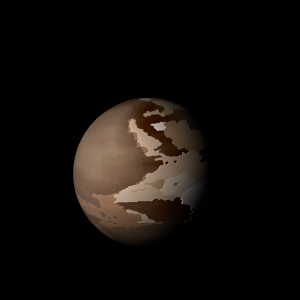|
|
Space Astro
|
Info for exoplanet "Dora"
| Scientific (actual) data |
|---|
| Planet | HIP 48714 b |
| Planet status | Confirmed |
| Mass sini | 0.0721 |
| Orbital period | 17.818 |
| Semi major axis | 0.112 |
| Orbit eccentricity | 0.5 |
| Discovered | 2020 |
| Updated | 2020-11-12 |
| Omega | 202 |
| Tperi | 2451540 |
| K | 9.35 |
| Publication | Published in a refereed paper |
| Detection type | Radial Velocity |
| Mass detection type | Radial Velocity |
| Star name | HIP 48714 |
| Right ascension | 149.04° |
| Declination | 62.79° |
| Mag v | 9.2 |
| Star distance | 10.533 |
| Star sp type | M0.5V |
| Wikipedia article | HIP 48714 b |
Back
| |
| Fictional info (?) |
|---|
| Suggested name | Dora |
| Planet type | Cold planet |
| Its orbital period around HIP 48714 of 18 earth days is the shortest of all the planets in its solar system.
This cold planet is named after the deity Dora, the creator of the underworld.
An observer on Dora would therefore see only one day every four years.
Plans have been proposed for rovers or more complex missions, but they are hindered by Dora's strong magnetosphere.
The rotational period and seasonal cycles of Dora are likewise similar to those of Rodita'the, as is the tilt that produces the seasons.
Dora has been explored on several occasions by robotic spacecraft, most notably during the early Pioneer and Wayfinder flyby missions and later by the Galileo orbiter.
The Dora system has a unique configuration among those of the planets because its axis of rotation is tilted sideways, nearly into the plane of its solar orbit. In 2383, images from Frontier 8 showed Dora as an almost featureless planet in visible light, without the cloud bands or storms associated with the other cold planets. |
| Estimated population | 5000000000 |
| Atmosphere | Oxygen | 69% |
| Methane | 27% |
| Carbon dioxide | 2.5% |
| Water | 0.12% |
| Atmospheric pressure | 0.07 bar |
 |
| No known satellites |
| Google search for Dora |
|
Website by Joachim Michaelis
|
|
|
|